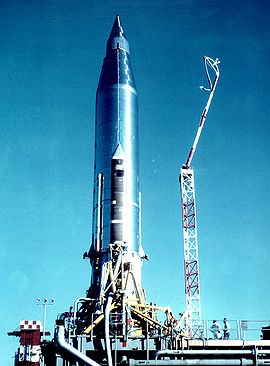
Project SCORE
Encyclopedia

Communications satellite
A communications satellite is an artificial satellite stationed in space for the purpose of telecommunications...
. Launched aboard an Atlas rocket on December 18, 1958, SCORE provided a first test of a communications relay system in space, as well as the first successful use of the Atlas as a launch vehicle. It captured world attention by broadcasting a Christmas message via short wave frequency from U.S. President Dwight D. Eisenhower
Dwight D. Eisenhower
Dwight David "Ike" Eisenhower was the 34th President of the United States, from 1953 until 1961. He was a five-star general in the United States Army...
through an on-board tape recorder.
Background
The six-month effort was the first endeavor of the then-new Advanced Research Projects Agency (ARPA) headed by Roy Johnson, and proved that a small, highly focused and versatile research group with appropriate resources was an ideal method to achieve the scientific and technological advances necessary to succeed in the emerging global space race.SCORE's technical objectives were two-fold. In addition to showing that an Atlas missile could be put into orbit, the project demonstrated the feasibility of transmitting messages through the upper atmosphere from one ground station to one or more ground stations. The result of the project, which used both real-time and store and forward
Store and forward
Store and forward is a telecommunications technique in which information is sent to an intermediate station where it is kept and sent at a later time to the final destination or to another intermediate station. The intermediate station, or node in a networking context, verifies the integrity of...
techniques, was a major scientific breakthrough which proved that active communications satellites could provide a means of transmitting messages from one point to any other on Earth.
Spacecraft
The SCORE communications package was designed and built by Kenneth Masterman-Smith, a military communication research engineer, along with other personnel with the U.S. Army Signal Research and Development Laboratory (SRDL) at Fort MonmouthFort Monmouth
Fort Monmouth was an installation of the Department of the Army in Monmouth County, New Jersey. The post is surrounded by the communities of Eatontown, Tinton Falls and Oceanport, New Jersey, and is located about 5 miles from the Atlantic Ocean. The post covers nearly of land, from the Shrewsbury...
, New Jersey
New Jersey
New Jersey is a state in the Northeastern and Middle Atlantic regions of the United States. , its population was 8,791,894. It is bordered on the north and east by the state of New York, on the southeast and south by the Atlantic Ocean, on the west by Pennsylvania and on the southwest by Delaware...
. The overall project was conducted in such secrecy that only 88 people were aware of its existence. Before the date of the SCORE launch, 53 of the 88 people had been told the project had been canceled and they were not to mention to anyone that it had ever existed. That left only 35 people who knew of the mission of Atlas 10B with the rest of the engineering crew, including the launch crew, under the impression that they were working solely on a test launch of the rocket.
The payload weighed 68 kg (150 pounds), and was built into the fairing pods of the Atlas missile. Combined weight of the total on-orbit package was 3969 kg (8750 pound). SCORE was placed into a 183 km by 1,481 km (114 mile
Mile
A mile is a unit of length, most commonly 5,280 feet . The mile of 5,280 feet is sometimes called the statute mile or land mile to distinguish it from the nautical mile...
by 920 mile) orbit, inclined 32.3 degrees, with a period of 101.5 minutes. Its batteries lasted 12 days and it reentered the atmosphere on 21 January 1959. The communications repeater installed on the missile receives a signal, amplifies it, and then retransmits it. Two redundant sets of equipment were mounted in the nose of the SCORE missile. Four antennas were mounted flush with the missile surface, two for transmission and two for reception. SCORE's other equipment included two tape recorders, each with a four-minute capacity. Any of four ground stations in the southern United States could command the satellite into playback mode to transmit the stored message or into record mode to receive and store a new message. These redundancies proved invaluable as one of the tape recorders malfunctioned and was rendered inoperable during the 12 day orbit.
The first transmitted message from space to the world below:
"This is the President of the United States speaking. Through the marvels of scientific advance, my voice is coming to you via a satellite circling in outer space. My message is a simple one: Through this unique means I convey to you and all mankind, America's wish for peace on Earth and goodwill toward men everywhere."
The broadcast signal for Eisenhower's greeting was fairly weak, and only very sensitive radio receivers were able to detect it. Most Americans heard the message as it was rebroadcast on commercial news programs.

